MARIANI’S
Virtual
Gourmet
May 30, 2021
NEWSLETTER
ARCHIVE

❖❖❖
IN THIS ISSUE
WITH PARIS NOT YET READY TO VISIT,
THINK ABOUT GOING TO THE REST OF FRANCE
By John Mariani
NEW YORK CORNER
ZERO OTTO NOVE,
ARMONK NY
By John Mariani
CAPONE'S GOLD
By John Mariani
NOTES FROM THE WINE CELLAR
WINES FOR FATHER'S DAY
By John Mariani
❖❖❖

On June 2 I'll be on the TV show Celebrating Act 2 with Art Kirsch and John Coleman talking about the subject of "Pizzerias, Trattorias and Ristoranti."
❖❖❖
IF
PARIS IS NOT YET READY FOR A VISIT,
THE REST OF FRANCE
IS WELL WORTH
CONSIDERING
By
John Mariani

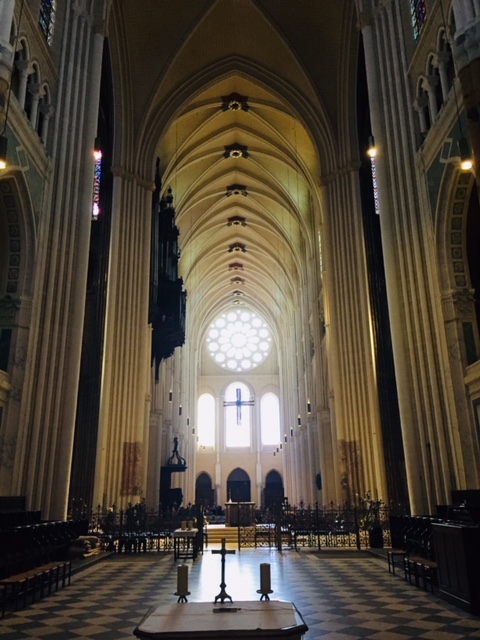 Indeed, Chartres
Cathedral, a World Heritage Site, is an
exquisite
example of the High Gothic style—even more
than Paris’s Notre Dame—and it’s
located a mere 50 miles from Paris. Five
different buildings had been on this
spot, dating back to the 4th century, with
the cathedral constructed between
1194 and 1220.
Indeed, Chartres
Cathedral, a World Heritage Site, is an
exquisite
example of the High Gothic style—even more
than Paris’s Notre Dame—and it’s
located a mere 50 miles from Paris. Five
different buildings had been on this
spot, dating back to the 4th century, with
the cathedral constructed between
1194 and 1220.Like most of the finest monuments in France, Chartres is now being scrubbed clean (when I visited the job was about three-quarters done) so that the creamy color of the stone and the radiance of the stained glass windows are as impressive as they were in its heyday. Massive flying buttresses—their first known use in a cathedral—take the load off the relatively thin walls, and two spectacularly decorated spires, each 340 feet in height, soar above a beautiful green copper roof. You can read much of biblical and Christian history in the hundreds of carved sculptural figures in and outside the cathedral, which has four portals. Its holiest relic is the Sancta Camisa, a tunic said to be worn by the Virgin Mary at Christ’s birth in Bethlehem.
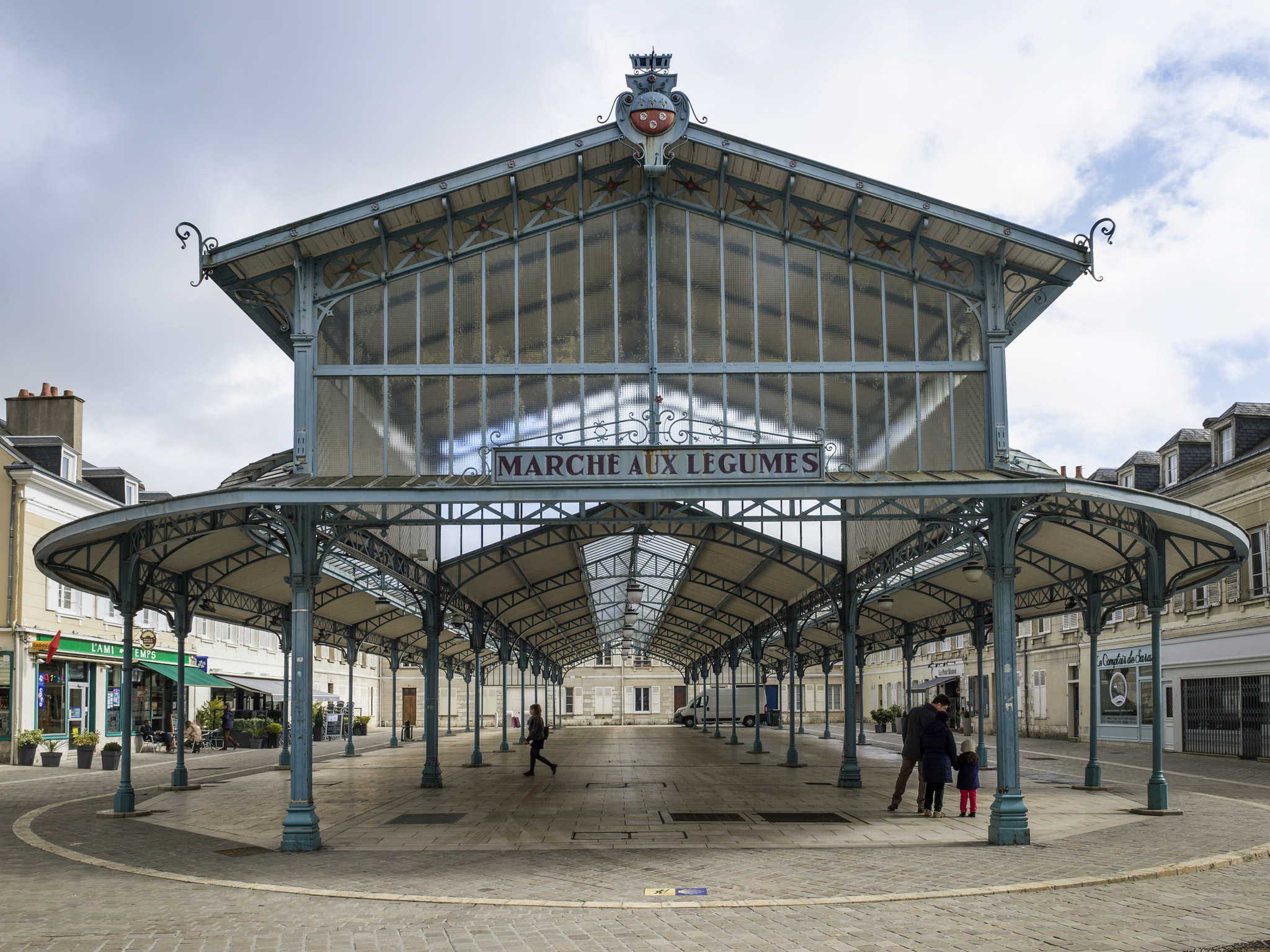
One of the nicest aspects of the cathedral is that it stands in a very open plaza, unlike so many churches in Europe crowded out by the surrounding buildings. In fact, since the city itself is set on a hill, the cathedral seen from any side rises into an unobstructed sky as if it exists independent of the hustle and bustle of an urban community. Then again, Chartres does not
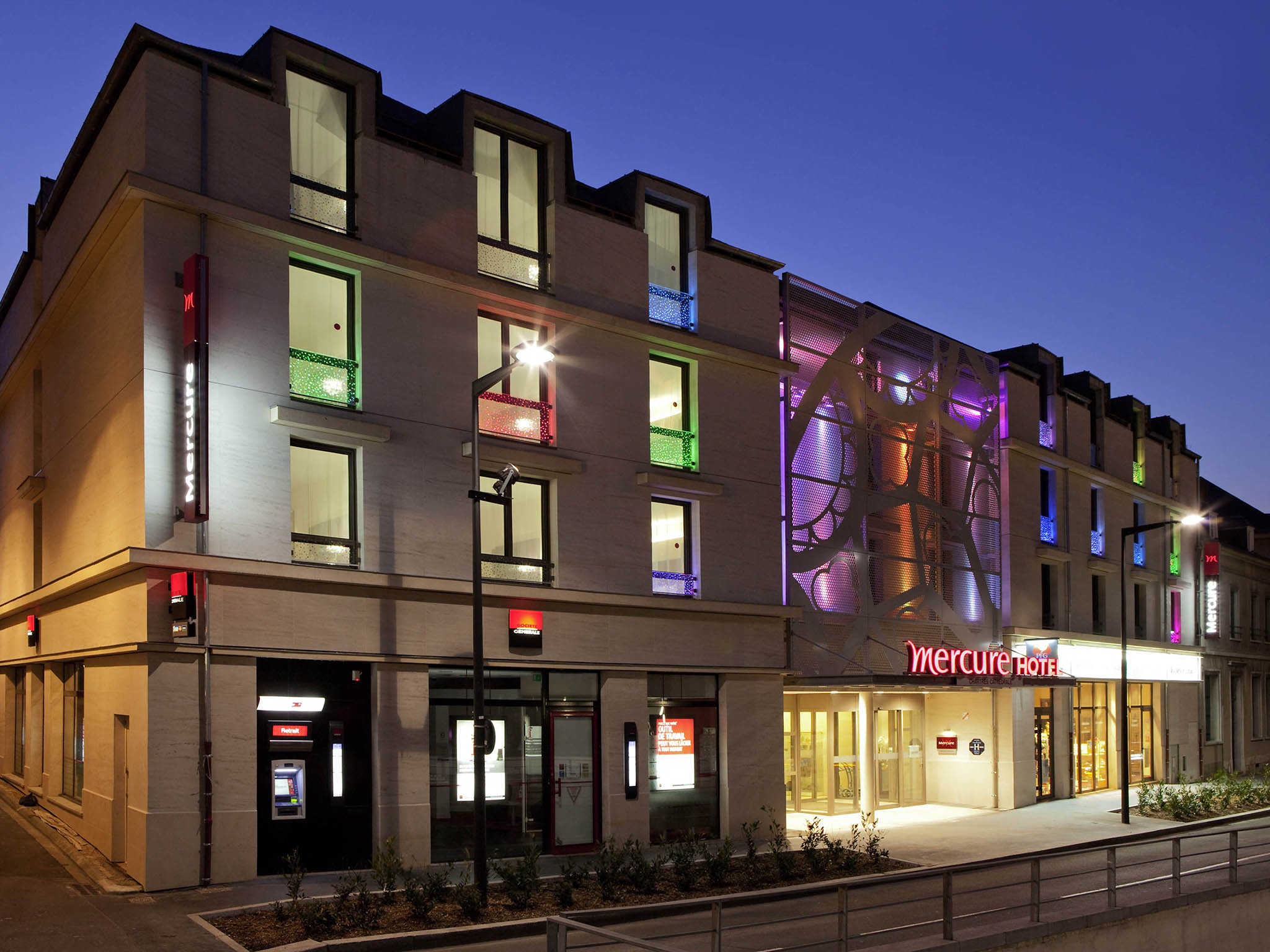 hustle
and bustle as much as many French cities,
and you can stroll
its streets in relative peace and quiet.
Only about 40,000 people live in
Chartres, and the city borders on the river
Eure, and a great field called
Beauce, known as the “granary of France.”
There is a fine arts museum adjacent
to the cathedral and a workshop museum
producing stained glass. A vegetable
market in art nouveau metalwork (above)
is open on weekends.
hustle
and bustle as much as many French cities,
and you can stroll
its streets in relative peace and quiet.
Only about 40,000 people live in
Chartres, and the city borders on the river
Eure, and a great field called
Beauce, known as the “granary of France.”
There is a fine arts museum adjacent
to the cathedral and a workshop museum
producing stained glass. A vegetable
market in art nouveau metalwork (above)
is open on weekends. We stayed at a fine, modern hotel nearby the cathedral called the Mercure Chartres Cathedrale (3 Rue de General Koenig) with a very courteous staff. (Current room rates posted are about $120, but you can book it on line
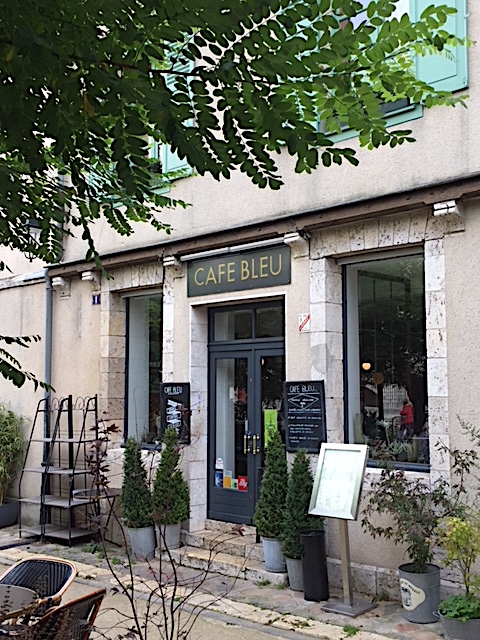 for about $104.)
Its boxy modernity almost makes it look out
of place,
but you get a lot of airy, natural lighted
room space. There is a bar and
breakfast room but no restaurant.
for about $104.)
Its boxy modernity almost makes it look out
of place,
but you get a lot of airy, natural lighted
room space. There is a bar and
breakfast room but no restaurant. 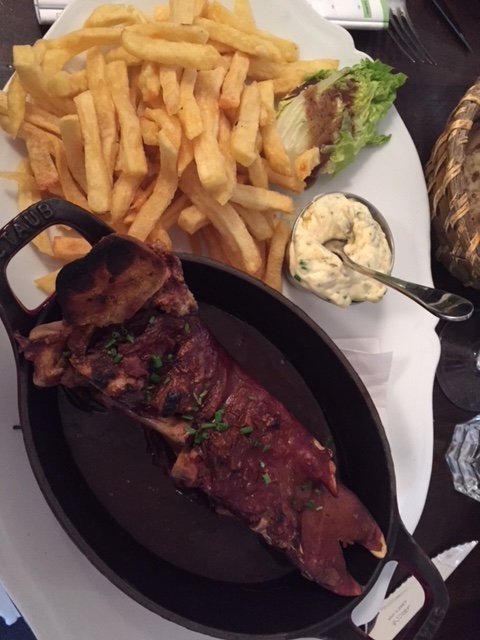 Right
across the street from the cathedral is the
charming,
five-year-old
Café Bleu (1
Cloître
Notre-Dame), where Chartres-born chef
Sandy Alexandre proudly serves the
local produce with a respect for tradition.
He offers a very reasonable à la
carte menu and prix
fixe meals at €30
for three courses. We enjoyed tender
leeks vinaigrette and
a delicious squash soup with chopped
hazelnuts and mascarpone whipped into it;
then came by a hearty pig’s trotter with
sauce gribiche and crisp frites (left);
and a breast of
chicken with shiitakes and a puree of carrot
and cream. For dessert we
shared a classic crème brûlée.
Right
across the street from the cathedral is the
charming,
five-year-old
Café Bleu (1
Cloître
Notre-Dame), where Chartres-born chef
Sandy Alexandre proudly serves the
local produce with a respect for tradition.
He offers a very reasonable à la
carte menu and prix
fixe meals at €30
for three courses. We enjoyed tender
leeks vinaigrette and
a delicious squash soup with chopped
hazelnuts and mascarpone whipped into it;
then came by a hearty pig’s trotter with
sauce gribiche and crisp frites (left);
and a breast of
chicken with shiitakes and a puree of carrot
and cream. For dessert we
shared a classic crème brûlée.That evening we dined somewhat more lavishly at L’Amphitryon (below) in the Le Boeuf Couronne hotel, which
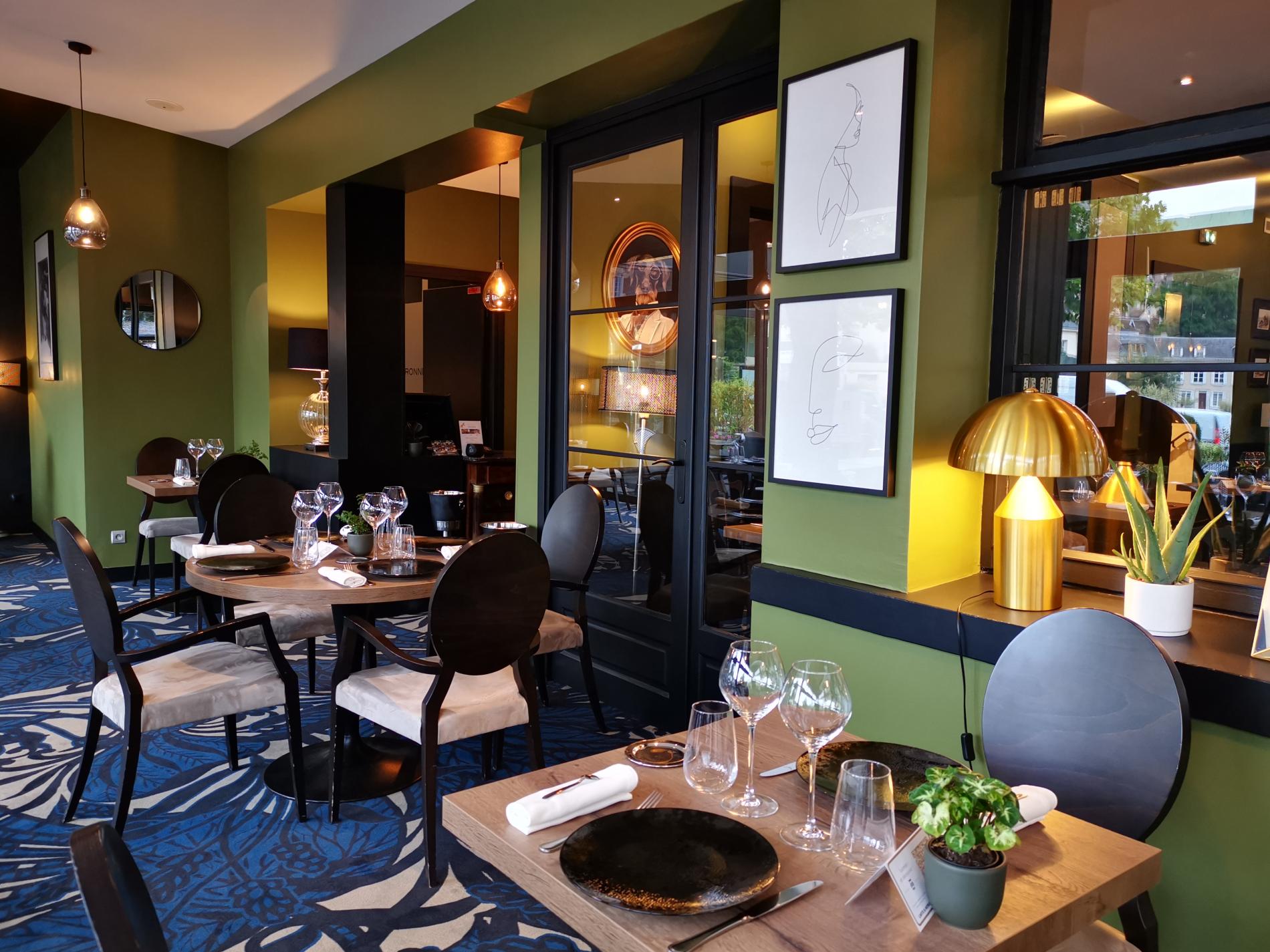 has just
reopened this month. Modern, and now
done
in deep, rich colors, it has a refined
casual ambience (which seems to
have been made even more comfortable than
when I visited), and the food
reflects its easygoing style. There is a €25
menu of the terroir of two courses, while
à la carte at dinner the appetizers
run €12 to €15 and main courses €20 to €25,
which is really a bargain. The wine
list is excellent.
has just
reopened this month. Modern, and now
done
in deep, rich colors, it has a refined
casual ambience (which seems to
have been made even more comfortable than
when I visited), and the food
reflects its easygoing style. There is a €25
menu of the terroir of two courses, while
à la carte at dinner the appetizers
run €12 to €15 and main courses €20 to €25,
which is really a bargain. The wine
list is excellent.  Our meal included a poached egg
Basque-style with Bayonne ham en
cocotte on crisp lightly browned puff
pastry; warm pink shrimp with avocado and a
freshly whipped mayonnaise; juicy guinea
fowl
in reduced jus with figs and thyme;
a filet mignon cooked rare, with whipped
potatoes full of butter; magret of duck with sweet
potatoes, fried chanterelles and apple
puree; a selection of local cheeses and
luscious
profiteroles with chocolate sauce (€9) and poached pear
with candied chestnuts (€10). Some of
the dishes could have used better seasoning,
but the
cooking shows the kind of consistent control
French culinary training demands.
Our meal included a poached egg
Basque-style with Bayonne ham en
cocotte on crisp lightly browned puff
pastry; warm pink shrimp with avocado and a
freshly whipped mayonnaise; juicy guinea
fowl
in reduced jus with figs and thyme;
a filet mignon cooked rare, with whipped
potatoes full of butter; magret of duck with sweet
potatoes, fried chanterelles and apple
puree; a selection of local cheeses and
luscious
profiteroles with chocolate sauce (€9) and poached pear
with candied chestnuts (€10). Some of
the dishes could have used better seasoning,
but the
cooking shows the kind of consistent control
French culinary training demands. In upcoming weeks I shall be writing about Rennes and St. Malo.
❖❖❖
NEW YORK CORNER
ARMONK NY
914-273-0089
By John Mariani

Westchester
County, New York City’s vast northern suburban
country along
the Hudson River, is some of the most beautiful
in the northeast and, if you
use your imagination, you might mistake it for
the lake country of northern
Italy like Lake Como and Lake Maggiore. So, it
seems only sensible that you’d
find a villa-like Italian country ristorante
that in décor and cooking mimics some of the
best in the Old Country.
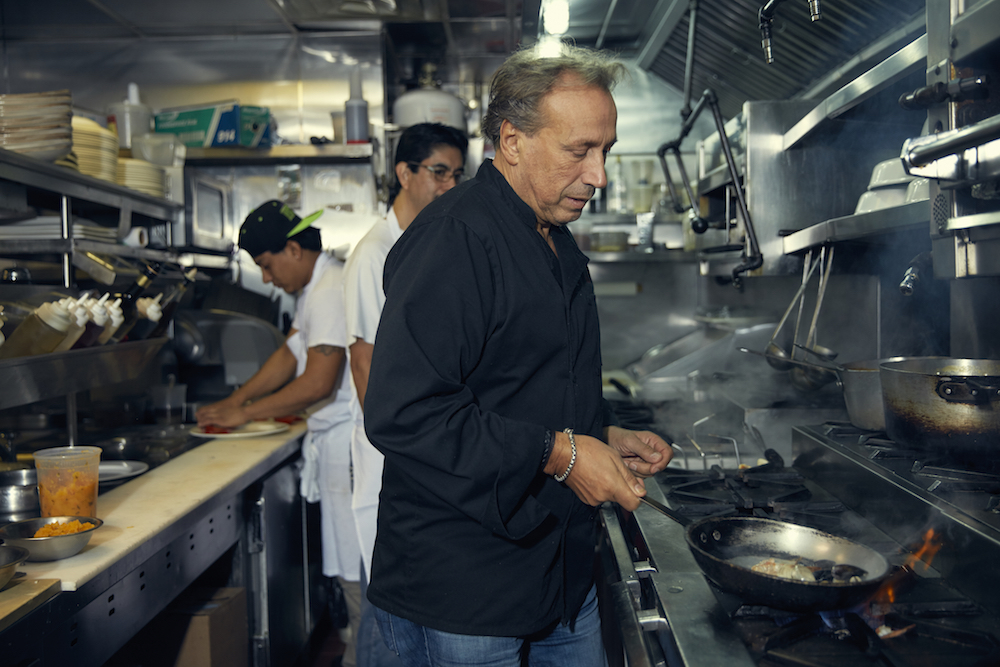 Its
name, Zero Otto Nove (089), however, evokes
southern Italy’s region
around Naples, whose telephone number prefix it
is. The owner, Roberto
Paciullo (left), hails from Sorrento, just
south of the sprawling city of Naples, and
over many years he’s built a mini-empire of five
trattorias and restaurants in
Manhattan, the Bronx and Westchester. He began on
Arthur Avenue in the Bronx
with Roberto’s, whose menu was a clear departure
from most of the copycat Italian-American
restaurants in that vibrant neighborhood near the
Bronx Zoo and Botanical
Gardens. Roberto’s offered authentic Italian
cuisine along with a stellar wine
list, and it became the kind of place New York
politicians, celebs and other
restaurateurs would go for lunch.
Its
name, Zero Otto Nove (089), however, evokes
southern Italy’s region
around Naples, whose telephone number prefix it
is. The owner, Roberto
Paciullo (left), hails from Sorrento, just
south of the sprawling city of Naples, and
over many years he’s built a mini-empire of five
trattorias and restaurants in
Manhattan, the Bronx and Westchester. He began on
Arthur Avenue in the Bronx
with Roberto’s, whose menu was a clear departure
from most of the copycat Italian-American
restaurants in that vibrant neighborhood near the
Bronx Zoo and Botanical
Gardens. Roberto’s offered authentic Italian
cuisine along with a stellar wine
list, and it became the kind of place New York
politicians, celebs and other
restaurateurs would go for lunch.
Paciullo opened his
first 089 on Arthur Avenue, then a second in
Manhattan’s Flat Iron district, then the third in
Armonk. At the moment, this
last may be his best. Located where it is within
green hills and woodlands not
far from the Kensico Dam, it is certainly his most
attractive, freestanding and
done is rustic colors and fabrics, rough-hewn
wooden beams, copper ductwork,
slate floors and a wrap-around verandah that is
especially appealing right now.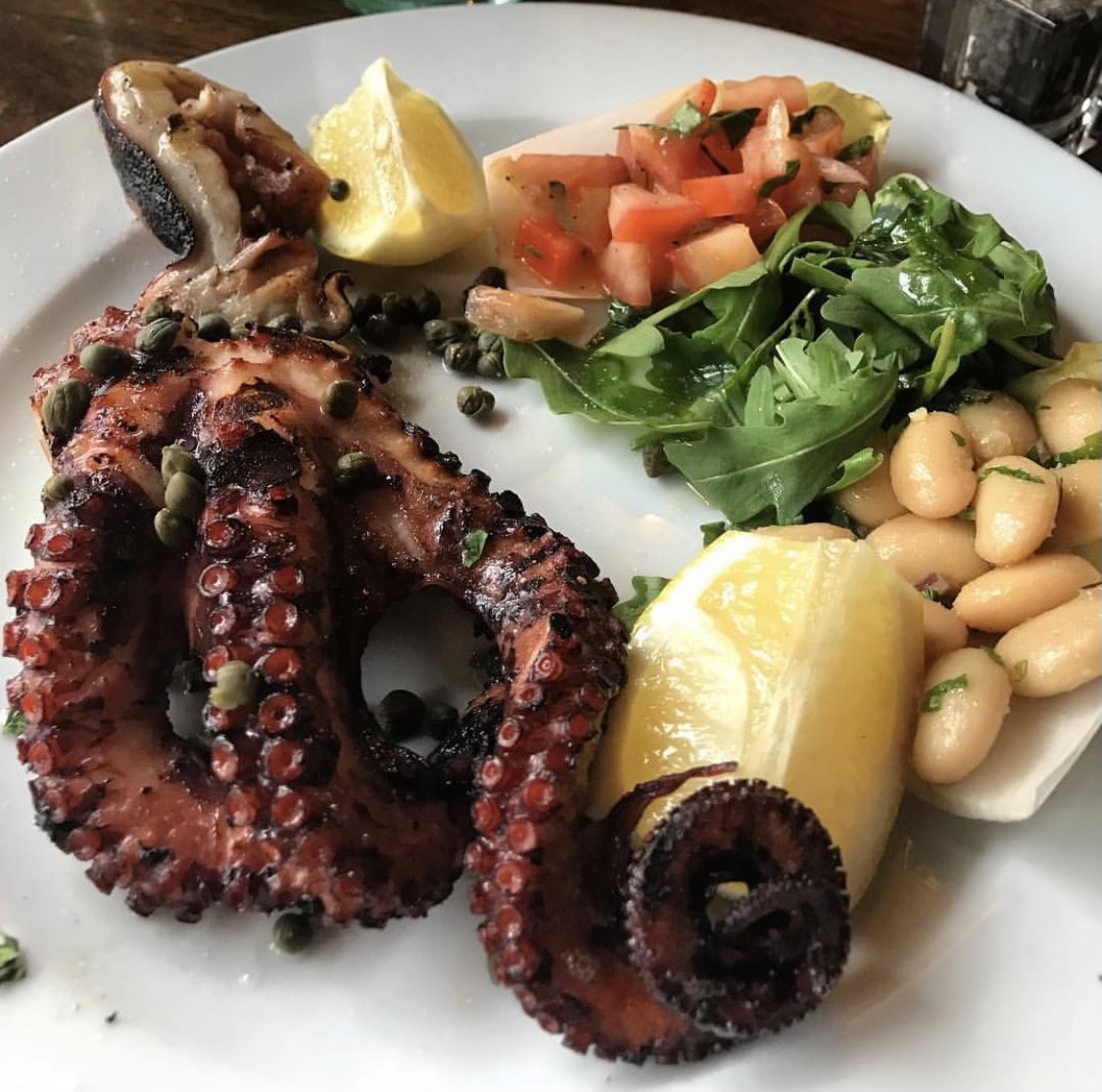
The menus are similar at all Zero
restaurants, though the Bronx original
is more focused on the pizzas, which are in the
Sorrento style, meaning they
have a puffy but crisp crust and a soft middle.
For those who like the
ultra-thin style of pizza, this is not your place.
The toppings are myriad,
from an excellent margherita ($16.95) to “Quattro
Latte” ($20.95) with
mozzarella, goat’s cheese, fontina, Parmigiano and
black truffle puree.
At Armonk, the menu is large, with ten
antipasti, including a platter of
various cheeses, vegetables and meats ($17.95); a
very well composed salad of
goat’s cheese, grilled pears, balsamic vinaigrette
and greens ($13.95); grilled
octopus (right) with fresh tomato, capers,
cannellini beans and olive oil ($17.95).
These and every dish at 089 are easy enough to
share.
 The
pastas are lavish, several in casseroles, like the
delicious baked
rigatoni Salernitana (left), bubbling hot
with meatballs, soppressata, ricotta,
mozzarella, sliced egg and tomato sauce ($25.95),
and a very rich radiator
(macaroni shaped like little radiators) cooked in
tinfoil with porcini
mushrooms, cherry tomatoes,
breadcrumbs and shaved Parmigiano ($25.95). On
occasion they also offer a
flavorful ravioli stuffed with shredded short ribs
in a cheese and butter cream
sauce ($23.95).
The
pastas are lavish, several in casseroles, like the
delicious baked
rigatoni Salernitana (left), bubbling hot
with meatballs, soppressata, ricotta,
mozzarella, sliced egg and tomato sauce ($25.95),
and a very rich radiator
(macaroni shaped like little radiators) cooked in
tinfoil with porcini
mushrooms, cherry tomatoes,
breadcrumbs and shaved Parmigiano ($25.95). On
occasion they also offer a
flavorful ravioli stuffed with shredded short ribs
in a cheese and butter cream
sauce ($23.95).
Among the main courses, I’ve found it’s
best to go with the more special
ones you won’t find anywhere else, like meltingly
tender short ribs long
braised in Peroni beer with cherry peppers and
topped with Gorgonzola  cheese
($25.95). The zuppa di
pesce (seafood
stew) is easily one of the best I’ve had in this
country, made with mussels,
clams, shrimp, calamari and other fish in a lusty
tomato sauce that you sop up
with the excellent bread on the table. I also
always trust Roberto to obtain
the freshest fish, and on a recent visit the Dover
sole was fresh and
impeccably cooked so it slipped off the bone; at
$30.95 it’s one of the best
bargains around.
cheese
($25.95). The zuppa di
pesce (seafood
stew) is easily one of the best I’ve had in this
country, made with mussels,
clams, shrimp, calamari and other fish in a lusty
tomato sauce that you sop up
with the excellent bread on the table. I also
always trust Roberto to obtain
the freshest fish, and on a recent visit the Dover
sole was fresh and
impeccably cooked so it slipped off the bone; at
$30.95 it’s one of the best
bargains around.
The
standard Italian dishes at 089, like bland veal
scallopine with
mozzarella and pesto ($29.95) and the underspiced
pollo scarpariello ($23.95), were no
better than many examples
you’d find in most area Italian restaurants. The
desserts are lavish and generous, like the
panna cotta and tiramisù, all made
in-house.
For a quick
meal or cocktail there’s a charming bar to the
right as you
enter and pass a meat locker displaying a huge
tomahawk steak that is aging for
weeks. A portion is meant for two ($115), but I
can guarantee it will serve
three, especially if you’d preceded it with a
pasta. The wine list is not as
extensive as at Roberto’s namesake’s in the Bronx,
but there are plenty of good
Italian bottlings at reasonable prices.
CAPONE’S
GOLD
“Hey, it’s
me.”
“Well, well,
well, I thought I wasn’t going to hear from
you by phone,” said Katie.
“Something about keeping things close to your
vest.”
“I was just
wondering how things are coming along out
there.”
“Tidbits. What
about you.”
“Yeah, tidbits
about describes it. I went out west, following
a hunch.”
“Whereabouts?”
“I can’t
really say. Confidential source.” David could
hear Katie take a breath.
“Confidential
source?” she repeated. “I thought we were
working on this together. You’re
not going to tell me everything you
find out?”
“Oh, I’ll tell
you everything I find out, but the source has
to stay confidential.”
“Why?”
“Because I
promised the guy who gave me the information
as to where the other source was
that I wouldn’t mention him in any way.”
David waited
for Katie to speak, and clearly she was not
happy.
“If that’s the
way you have to work it, then I guess I just
have to accept it and shut up,”
she said.
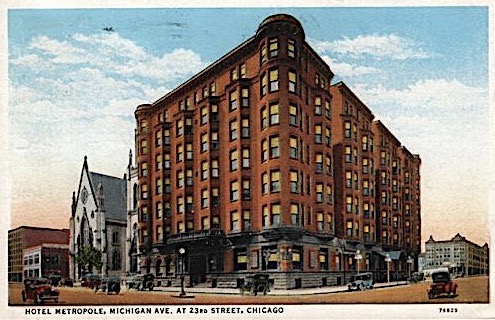 “Katie,”
said
David, “I’d expect the same from you.
You’re a reporter, you have
confidential sources. Do
you have to tell your editor who they
are?”
“Katie,”
said
David, “I’d expect the same from you.
You’re a reporter, you have
confidential sources. Do
you have to tell your editor who they
are?”
“Oh, they beg
me to tell them, even threaten me to tell
them.
Ever since the Watergate exposé,
editors are very careful to get two or
three sources to back up a confidential one.”
“Well, if it
makes you feel any better,” said David, “the
only information I got from my
confidential source was that there were three
trucks used to haul away the gold
from the armored truck and they all drove off
in different directions.”
“That’s it?
That’s all you got?”
“That and the
details of how they did it.”
“Well, that’s
good to know. Hey, how were your expenses?”
“Next to
nothing.
I flew out in the morning,
caught a red eye that evening. Southwest
Airlines.
Oh, and I got a cheap rental car.”
Katie
sounded
ready to move on and said, “Well, on my end I
have a lot more reports on Capone
from files in the Chicago papers. I’ve
spent the last two days in the library,
reading microfiche and taking photos of
the relevant pages.
“I’ve also
been going to a lot of the places Capone hung
out at back in the day, mostly
for color and background. I
was hoping
to visit both the Metropole Hotel (above),
where Capone lived as of 1925, and the
Lexington Hotel (below), where he took
over the entire fifth floor in 1928. The floor
was ringed with rooms for his bodyguards.
For some reason he registered as a 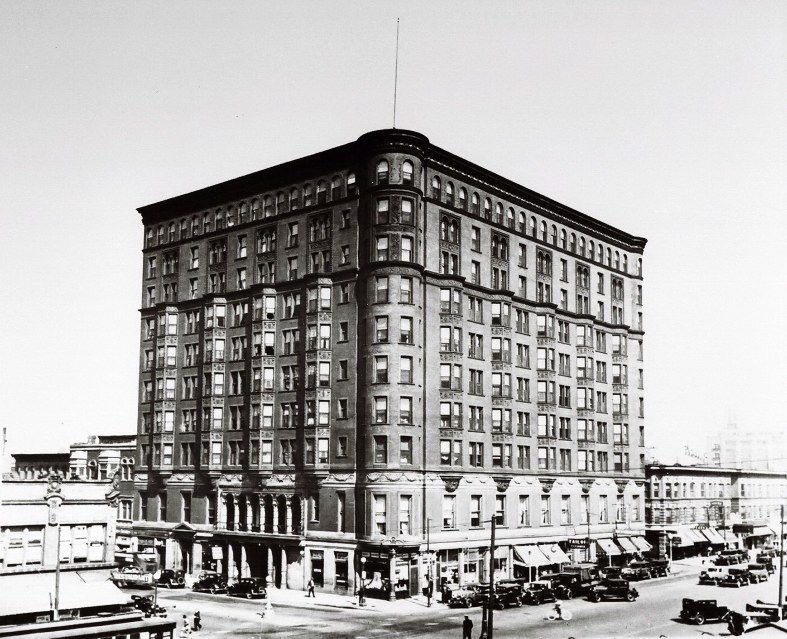 ‘George
Philips.’ Why a guy as well
known as Al Capone would use an alias, I can’t
figure.”
‘George
Philips.’ Why a guy as well
known as Al Capone would use an alias, I can’t
figure.”
“Those guys
got used to having aliases,” said David.
Katie
continued. “So Capone lived there until his
arrest for carrying an illegal gun
in Pennsylvania, spent a few months in jail,
then moved back to Chicago when he
got out.
Weird thing is, David, I ran
across these stories that his bodyguards would
run into his bedroom to find him
raving from a nightmare about seeing ghosts
and begging them to leave him
alone. He
even hired a psychic, name
of”—Katie flipped over a page in her
notes—“Alice Britt, who held séances in
Al’s dining room.”
“Any chance
she’s still alive?”
“I don’t know
yet. I
haven’t found anything more out
about her. No obituary, though.”
“Okay, so what
else?” asked David.
“After Capone
was sent to prison in 1932, his men moved out
of the hotel, but not before
they’d made some major additions to the
place.”
“Like what?”
“Like
tunnels.”
“The Geraldo
Rivera tunnel,” laughed David.
“Yep. And
others.”
“Yeah, I
talked to an F.B.I. colleague who said they
were all thoroughly searched.”
“Well, it’s
all gone now,” she said. “The place turned
into a bordello, then a drug house
and was demolished five years ago. The
Metropole was gone long before that.”
“Anything
else?” he asked.
 “One of the
speakeasies Capone hung out in—maybe he owned
it—near his home was called the
226 Club,
and it’s now the Exchequer
Pub, decked out with a lot of 1930s
memorabilia. And . . . let’s see. Oh,
did you know that if a place back then
had a green door, it was probably a speakeasy?
There’s still a place called The Green
Door Tavern that dates back to
1872. Capone went there, too.”
“One of the
speakeasies Capone hung out in—maybe he owned
it—near his home was called the
226 Club,
and it’s now the Exchequer
Pub, decked out with a lot of 1930s
memorabilia. And . . . let’s see. Oh,
did you know that if a place back then
had a green door, it was probably a speakeasy?
There’s still a place called The Green
Door Tavern that dates back to
1872. Capone went there, too.”
“Imagine
that,” said David, who thought all this
research was going nowhere.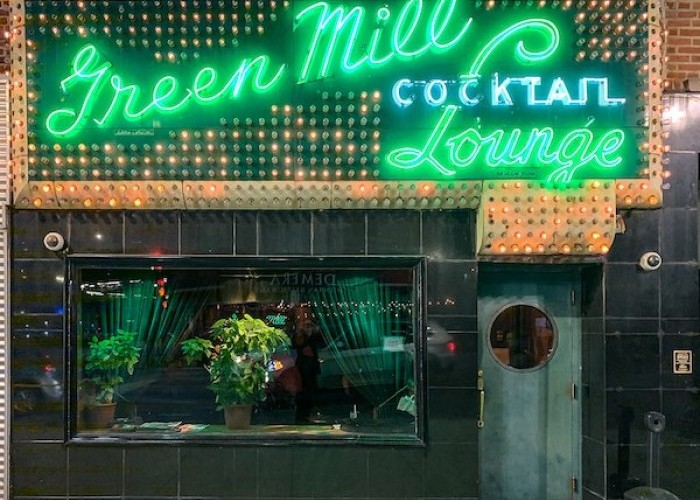
“The Green
Mill Tavern still exists. It used to be
‘Machine Gun’ McGurk’s place. Halligan’s—still
here—was Bugs Moran’s. Out
in Cicero I had lunch at a Czech restaurant
named Klas that opened in 1922,
not far from Capone’s headquarters.”
David was
thinking to himself, this girl’s going to have
a lot of color in her story, if
there really is a story.
“Did you go out
to Capone’s house?”
“Actually I
wanted to speak to you about that,” she said.
“I went by it on my way in from the
airport, and it’s still there and
occupied.
It’s really a pretty modest,
two-story brick house with a big garage out
back. But—and you’re going to say
I’m a wimp—I couldn’t get up the courage to
knock on the door and see if I
could get inside. What would you have done,
David?”
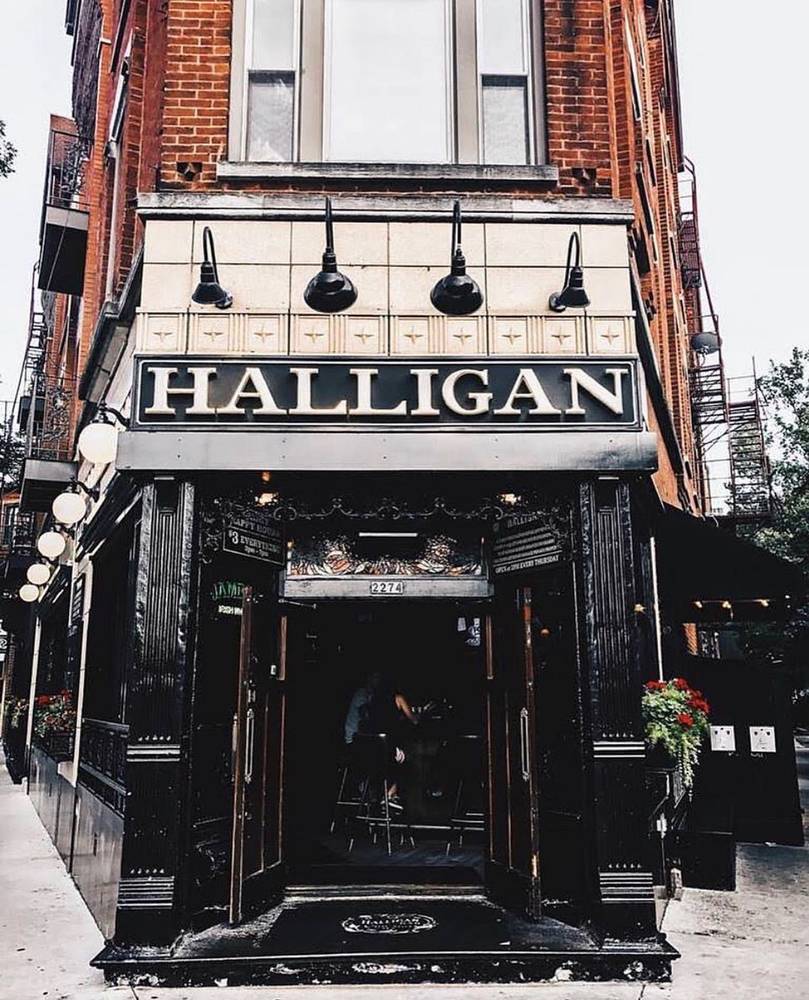 “I would
have knocked
on the door and asked if I could come inside.”
“I would
have knocked
on the door and asked if I could come inside.”
“You mean you’d
use your police badge?”
“Not any more I
couldn’t.
But if you just explain who
you are and what you’re doing, maybe they’ll
be nice enough to let you in.”
“But they must
have lots of curiosity seekers drop by like
that.”
David sighed
and
said, “All right, here’s what you do.
I’m going to call a cop friend of mine
in Chicago and I’ll ask him to
vouch for you, write you a letter of intro.
That should do it. No
one likes
to refuse anything on official police
letterhead.
It’ll just say you are in fact a
reporter
doing research on Capone and could you look
around for five minutes.”
“Oh, David, that
would be so great. When could you do that?
I was planning on going back to New
York tomorrow, but I’ll stay on if I
have to.”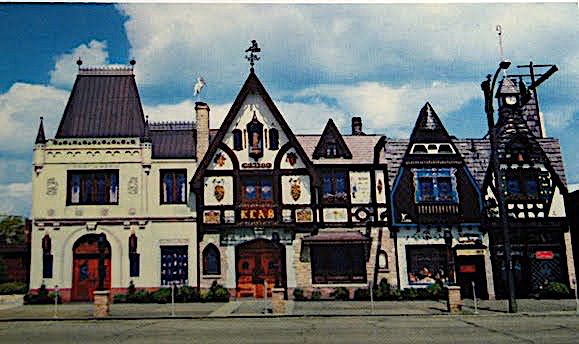
“I’ll call him
right now. Here, take his name down and,
unless you hear otherwise from me, go
over to the precinct around four o’clock.
You’ll be at your hotel?”
“Yes, I’ll do
some paperwork and wait for your call.”
“All right, I’ll
call you one way or the other. Anything
else?”
There was a
pause and the sound of Katie clearing her
throat.
“No, that’s it
for now,” she said.
“Well, then,
stay well,” said David, who wished he were out
there with her in Chicago. Just
to make sure things went well.
© John Mariani, 2015
❖❖❖
NOTES FROM THE WINE CELLAR
LIKES ON FATHER'S DAY
By John Mariani
When
my two sons come over for Father’s Day, I let
them pick the wines. They know
what I like, which are wines without too much
alcohol, a real show of terroir
and compatibility with what they’ll be cooking
outside. Here are a few I’d be
very happy for them to choose (so I hope
they’re reading this).
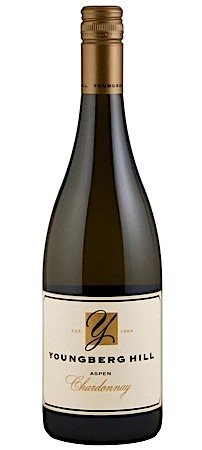 Youngberg
Hill 2019 Aspen Chardonnay ($40)—In the 2019 vintage, rain
and a
cool October in Oregon slowed down the sugar
build-up, so the grapes were
picked at optimum time so as to emerge as wines
with a sensible alcohol level
of 12%, which is rare on the West Coast these
days. There’s just a hint of oak
and a layering of fruit and citrus flavors, with
no residual sugar. It may
remind you of a Cru Chablis and will go well
with chicken or cheeses.
Youngberg
Hill 2019 Aspen Chardonnay ($40)—In the 2019 vintage, rain
and a
cool October in Oregon slowed down the sugar
build-up, so the grapes were
picked at optimum time so as to emerge as wines
with a sensible alcohol level
of 12%, which is rare on the West Coast these
days. There’s just a hint of oak
and a layering of fruit and citrus flavors, with
no residual sugar. It may
remind you of a Cru Chablis and will go well
with chicken or cheeses.
Querceto
di Castellina SEI Gran Selezione Chianti
Classico 2017
($50)—Further proof that the best Chianti
Classicos can readily rival the
so-called Super Tuscans by showing power but not
too much alcohol, a velvety
quality and wonderful undertones of light tannin
and sweetness. One wine writer
suggested there is Merlot in the bottle with
Sangiovese, probably because it
has such a smooth texture and ripeness. The name
SEI (six) comes from the
single vineyard of 6.6 hectares producing 6,666
bottles.
Capezzana
Corte Bonacossi Villa di Capezzana Carmignano
2016
($30)—Carmignano was given official status by
Tuscan Cosimo III de Medici in
1716, and it’s one of the region’s noble wines,
though not as well-known as
Brunello di Montalcino. Along
with
Sangiovese, the wines always include some
Cabernet Sauvignon that imparts a
bolder, more tannic element, so it needs four
years or more to settle into
equilibrium with its abundant fruit. Great wine
with beef or veal.
Roero
Bric Paradiso Riserva 2016 ($95)—A sumptuous Piemontese
Nebbiolo
from a small DOCG district controlled by the
Roero family. (They also make a
Roero Arneis white wine). There is a good deal
of spice and nut flavors with
wonderful fragrance. It’s pricey and something
of a rarity a connoisseur will
much appreciate. 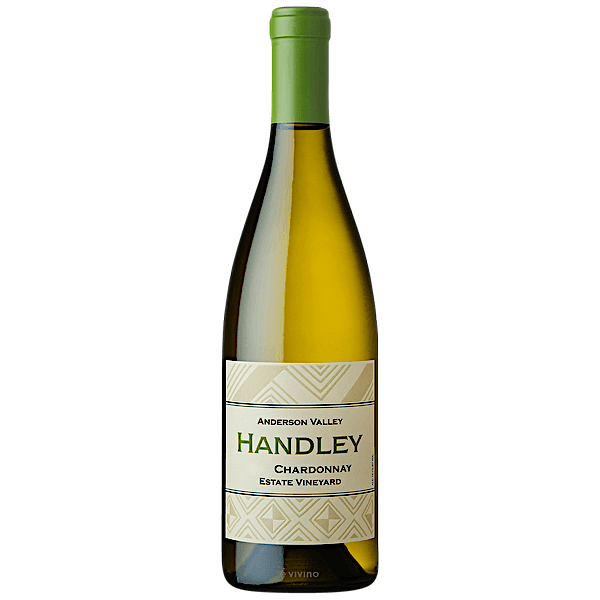
Caprio
Cellars Eleanor Estate Red Wine 2018 ($48)—From Walla Walla
comes this very, very good blend of 59% Cabernet
Sauvignon, 19% Merlot, 15%
Malbec and 7% Cabernet Franc, which makes it a
Bordeaux style red wine, aged
for 18 months in French oak. The alcohol is a
little high at 14.5%, but the
fruit and minerals are strong enough to keep it
in check. At the moment the
2018 and 2017 are available in the market.
Surrau
Isola Nuraghi 2019 ($17)—This was wholly new to me,
as
might be expected since it’s the first wine ever
produced at Vigne Surrau in
the Surrau Valley in Sardinia. The Demuro
brothers planted and used the
island’s indigenous grapes—30% Cannonau, 10%
Muristellu, and 60% Carignano—from
sandy soil and vines 20 years old. The wines
spend time in both oak and
old-fashioned cement vats, aging for 9 months,
then 3 months in bottle. The
alcohol is 14%. If you like big, but not
punch-like, fruit, this is a terrific
red wine and ridiculously cheap. Good to go with
any meats.
Handley
Anderson Valley Chardonnay 2017 ($27)—This wine from
a close-to-the Pacific Coast winery, established
in 1982, is a fine example of
its particular terroir, and three years of aging
has ennobled the basic structure,
with 13.2% alcohol. It’s lively and rich, and,
if you close your eyes, maybe
you’ll smell the ocean, which makes it good for
all shellfish, not least
Dungeness crab and abalone.
❖❖❖
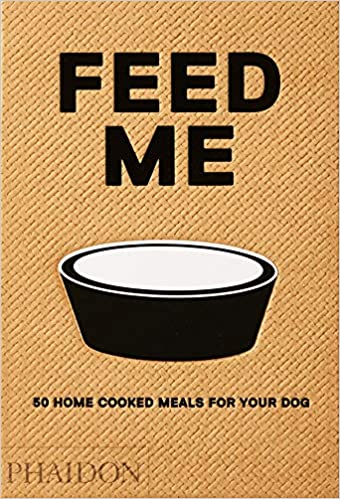
FOOD HE COULD EAT THE DUMB BOOK
❖❖❖
Sponsored by

Any of John Mariani's books below may be ordered from amazon.com.
 The Hound in Heaven
(21st Century Lion Books) is a novella, and
for anyone who loves dogs, Christmas, romance,
inspiration, even the supernatural, I hope you'll find
this to be a treasured favorite. The story
concerns how, after a New England teacher, his wife and
their two daughters adopt a stray puppy found in their
barn in northern Maine, their lives seem full of promise.
But when tragedy strikes, their wonderful dog Lazarus and
the spirit of Christmas are the only things that may bring
his master back from the edge of despair.
The Hound in Heaven
(21st Century Lion Books) is a novella, and
for anyone who loves dogs, Christmas, romance,
inspiration, even the supernatural, I hope you'll find
this to be a treasured favorite. The story
concerns how, after a New England teacher, his wife and
their two daughters adopt a stray puppy found in their
barn in northern Maine, their lives seem full of promise.
But when tragedy strikes, their wonderful dog Lazarus and
the spirit of Christmas are the only things that may bring
his master back from the edge of despair. WATCH THE VIDEO!
“What a huge surprise turn this story took! I was completely stunned! I truly enjoyed this book and its message.” – Actress Ali MacGraw
“He had me at Page One. The amount of heart, human insight, soul searching, and deft literary strength that John Mariani pours into this airtight novella is vertigo-inducing. Perhaps ‘wow’ would be the best comment.” – James Dalessandro, author of Bohemian Heart and 1906.
“John Mariani’s Hound in Heaven starts with a well-painted portrayal of an American family, along with the requisite dog. A surprise event flips the action of the novel and captures us for a voyage leading to a hopeful and heart-warming message. A page turning, one sitting read, it’s the perfect antidote for the winter and promotion of holiday celebration.” – Ann Pearlman, author of The Christmas Cookie Club and A Gift for my Sister.
“John Mariani’s concise, achingly beautiful novella pulls a literary rabbit out of a hat – a mash-up of the cosmic and the intimate, the tragic and the heart-warming – a Christmas tale for all ages, and all faiths. Read it to your children, read it to yourself… but read it. Early and often. Highly recommended.” – Jay Bonansinga, New York Times bestselling author of Pinkerton’s War, The Sinking of The Eastland, and The Walking Dead: The Road To Woodbury.
“Amazing things happen when you open your heart to an animal. The Hound in Heaven delivers a powerful story of healing that is forged in the spiritual relationship between a man and his best friend. The book brings a message of hope that can enrich our images of family, love, and loss.” – Dr. Barbara Royal, author of The Royal Treatment.
 |
The Encyclopedia of American Food and Drink by John F. Mariani (Bloomsbury USA, $35) Modesty forbids me to praise my own new book, but let me proudly say that it is an extensive revision of the 4th edition that appeared more than a decade ago, before locavores, molecular cuisine, modernist cuisine, the Food Network and so much more, now included. Word origins have been completely updated, as have per capita consumption and production stats. Most important, for the first time since publication in the 1980s, the book includes more than 100 biographies of Americans who have changed the way we cook, eat and drink -- from Fannie Farmer and Julia Child to Robert Mondavi and Thomas Keller. "This book is amazing! It has entries for everything from `abalone' to `zwieback,' plus more than 500 recipes for classic American dishes and drinks."--Devra First, The Boston Globe. "Much needed in any kitchen library."--Bon Appetit. |
"Eating Italian will never be the same after reading John Mariani's entertaining and savory gastronomical history of the cuisine of Italy and how it won over appetites worldwide. . . . This book is such a tasteful narrative that it will literally make you hungry for Italian food and arouse your appetite for gastronomical history."--Don Oldenburg, USA Today. "Italian
restaurants--some good, some glitzy--far
outnumber their French rivals. Many of
these establishments are zestfully described
in How Italian Food Conquered the World, an
entertaining and fact-filled chronicle by
food-and-wine correspondent John F.
Mariani."--Aram Bakshian Jr., Wall Street
Journal.
"Equal parts
history, sociology, gastronomy, and just
plain fun, How Italian Food Conquered the
World tells the captivating and delicious
story of the (let's face it) everybody's
favorite cuisine with clarity, verve and
more than one surprise."--Colman Andrews,
editorial director of The Daily
Meal.com. "A fantastic and fascinating
read, covering everything from the influence
of Venice's spice trade to the impact of
Italian immigrants in America and the
evolution of alta cucina. This book will
serve as a terrific resource to anyone
interested in the real story of Italian
food."--Mary Ann Esposito, host of PBS-TV's
Ciao
Italia. "John Mariani has written the
definitive history of how Italians won their
way into our hearts, minds, and
stomachs. It's a story of pleasure over
pomp and taste over technique."--Danny Meyer,
owner of NYC restaurants Union Square
Cafe, The Modern, and Maialino.
|
 |
 |
 |
 |
 |
 |
 Everett Potter's Travel Report:
Everett Potter's Travel Report: 
 Eating Las
Vegas JOHN CURTAS has been covering
the Las Vegas food and restaurant scene
since 1995. He is the co-author of EATING LAS
VEGAS – The 50 Essential Restaurants (as
well as the author of the Eating Las
Vegas web site: www.eatinglasvegas.
He can also be seen every Friday morning as
the “resident foodie” for Wake Up With the
Wagners on KSNV TV (NBC) Channel 3 in
Las Vegas.
Eating Las
Vegas JOHN CURTAS has been covering
the Las Vegas food and restaurant scene
since 1995. He is the co-author of EATING LAS
VEGAS – The 50 Essential Restaurants (as
well as the author of the Eating Las
Vegas web site: www.eatinglasvegas.
He can also be seen every Friday morning as
the “resident foodie” for Wake Up With the
Wagners on KSNV TV (NBC) Channel 3 in
Las Vegas.
MARIANI'S VIRTUAL GOURMET
NEWSLETTER is published weekly. Publisher: John Mariani. Editor: Walter Bagley. Contributing Writers: Christopher Mariani,
Robert Mariani, Misha Mariani, John A. Curtas, Gerry Dawes, Geoff Kalish,
and Brian Freedman. Contributing
Photographer: Galina Dargery. Technical
Advisor: Gerry
McLoughlin.
If you wish to subscribe to this
newsletter, please click here: http://www.johnmariani.com/subscribe/index.html
© copyright John Mariani 2021

